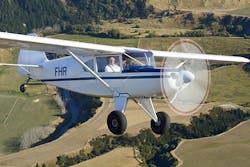AUSTIN, TEXAS, JULY 24, 2016 – Bearhawk Aircraft announced today the unveiling of its Bearhawk Bravo. The Bravo is a refinement of the 4-place Bearhawk design that established the family of Bearhawk aircraft. The Bearhawk Bravo, referred to internally as the model “B,” will be available as both a plans-built design and a Quick-Build kit. The aircraft features best-in-class speed, STOL capability, and large payload carrying capacity. The original design and modifications are by renowned aviator, mechanic and engineer Bob Barrows.
“For some time Bob has wanted to incorporate into the 4-place Bearhawk certain design features of his more recent aircraft, namely the Bearhawk Patrol and Bearhawk LSA,” stated Mark Goldberg, president of Bearhawk Aircraft and manufacturer of Bearhawk Quick-Build kits. Originally designed in 1994, the Bearhawk was apropos for enhancements following its 22-year tenure.
Most prominent among the design changes to the 4-place Bearhawk model “B” is the use of a Riblett 30-413.5 airfoil, as incorporated into the 2-place Bearhawk Patrol. Following his study of the airfoil, Barrows felt the Riblett would offer some advantages over the Bearhawk’s original NACA 4412 airfoil. Flight tests proved his thesis correct with the new wings producing gains in the range of five to eight MPH faster. This speed increase is coupled with similar if not better stall speeds, yet conclusively greater stability in induced stall.
Test pilot Wayne Massey explained, “Having flown the Bearhawk many hours prior, I was at first apprehensive when I heard that modifications were to be made. I liked the way the model ‘A’ airplane flew and I didn’t want the feel of the airplane changing. Now having flown the model ‘B’ for several hours I feel that the changes were worthwhile. The increase in cruise speeds makes it an even greater cross-country airplane.
“The original 4-place Bearhawk already had excellent stall characteristics and the model ‘B’ with its Riblett airfoil enhances the stall characteristics even more. Performing full aft stick wings level power off stalls in the model ‘A’ leads to a stable leaf stall. Continuing to hold full aft stick in the stall, the nose drops just enough to recover some airspeed then goes back into a leaf stall again remaining very stable. On the new model ‘B,’ performing full aft stick power off stalls leads to a wings level stable full stall and a sink rate of around 1,200 fpm. While holding full aft stick in the stall, the wings remain level and the nose does not drop, the aircraft does not leaf stall.
“In a moose stall the Bearhawk model ‘B’ now performs similarly to the Patrol. In a turn with some power on and speed diminishing, there’s a very slight buffet at around 35–40 IAS, yet the aircraft remains very stable with no noticeable tendency to drop a wing in the opposite direction. Gentle forward pressure on the stick leads to an instant, stable airspeed recovery.”
Additional changes incorporated into the Bearhawk Bravo are:
- Use of aluminum fuselage formers, window sills, and door sills in place of steel formers and sills offering weight savings and corrosion resistance.
- Use of airfoil shaped ribs on the horizontal and vertical stabilizers as opposed to flat ribs giving enhanced stability, more control authority, and a speed increase of three MPH due to the change from four to three degrees of down deflection of the horizontal stabilizers.
- Use of shock struts made from heavy wall round tubing in place of streamlined tubing providing more resistance to side load failure while on the runway. The round tube is faired with streamlined PVC to neutralize drag.
- Use of a round tail spring fabricated from 6150 heat treated alloy steel bar in place of the leaf-type spring set providing a small weight savings and better flex/spring effect in any direction. The round profile also has the potential to save the rear fuselage from damage at unpaved strips.
- Use of the aforementioned Riblett airfoil wings with one-foot longer wingspan and an additional five square feet of wing area.
See the new Bearhawk Bravo at AirVenture Oshkosh 2016 in booth #630 in the North Aircraft Display. Bearhawk Aircraft manufactures high-quality Quick-Build aircraft kits for the Bearhawk Bravo, two-place tandem Bearhawk Patrol, and Bearhawk LSA. Designed by engineer Bob Barrows, the Bearhawks have in common excellent performance and superb flying characteristics. Bearhawks are known for their short field capability, higher than expected cruise speeds, and very gentle slow speed manners. For utility and recreational use, customers around the world fly Bearhawk aircraft.
For more information on Bearhawk Aircraft, visit www.bearhawkaircraft.com, or contact Bearhawk at [email protected] or 1-877-528-4776.


